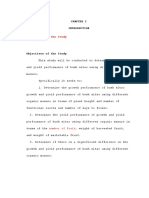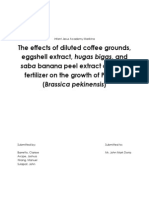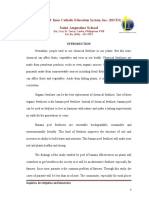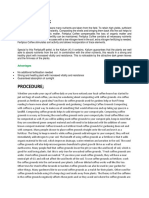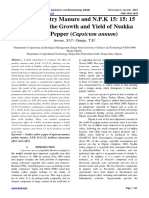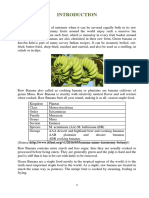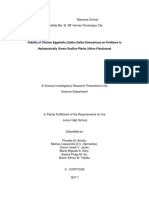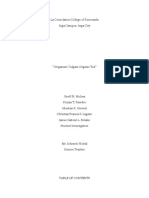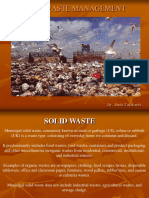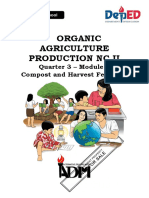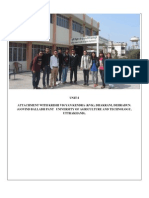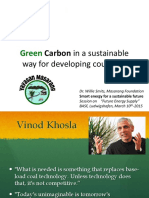Professional Documents
Culture Documents
Physical and Chemical Properties of Organic Fertilizer From Banana (Musa Paradisiaca) Leaf and Stem With Effective Microorganism Activactors (EM4)
Copyright
Available Formats
Share this document
Did you find this document useful?
Is this content inappropriate?
Report this DocumentCopyright:
Available Formats
Physical and Chemical Properties of Organic Fertilizer From Banana (Musa Paradisiaca) Leaf and Stem With Effective Microorganism Activactors (EM4)
Copyright:
Available Formats
Volume 7, Issue 11, November – 2022 International Journal of Innovative Science and Research Technology
ISSN No:-2456-2165
Physical and Chemical Properties of Organic
Fertilizer from Banana (Musa Paradisiaca)
Leaf and Stem with Effective Microorganism
Activactors (EM4)
Yuanita , F.Silvi Dwi Mentari, Roby, Riama Rita Manullang, Faradilla, Haryatie Sarie
Politeknik Pertanian Negeri Samarinda
Kampus Gunung Panjang Jl. Samratulangi Samarinda 75131
telp. 0541-260421/fax 0541-260680
Abstract:- Organic fertilizers are fertilizers derived from through an engineering process, in solid or liquid form, can be
weathering of organic matter in the form of plant residues, enriched with minerals or microbes that are useful for
animal waste and can come from household waste or increasing nutrient content and soil organic matter and
industrial waste. One of the organic materials that can be improving physical properties, chemistry, and soil biology.
used as solid organic fertilizer is banana leaves and stems.
The process of making solid organic fertilizer with the Banana tree trunks have many benefits, one of which is
addition of dissolved effective microorganisms (EM 4) to fertilize plants. Therefore, banana tree trunks can be
accelerates the composting process well. processed into organic fertilizer which has a very large role for
soil fertility. Banana tree trunks can be processed into solid
This study aims to observe the physical properties of organic fertilizer, or used as a compost mixture by chopping it
fertilizers (color, aroma, shape and temperature) and into fine pieces, then mixed with other organic materials to be
chemical properties (pH, N, P, K, C-Organic and C/N processed into compost. Banana leaves can also be processed
Ratio or analyze the nutrient content of organic fertilizers into fertilizer and as organic material and used as a planting
from banana leaves and stems with Bioactivator Effective medium. Especially the leaves that have been dried and
microorganism (EM4). mashed to be used as a planting medium for ornamental plants,
as well as for vegetables (Abdul, 2021).
This research was conducted at the Production
Laboratory of the Plantation Cultivation Study Program Given the importance of the function and role of organic
and the Laboratory of Soil Science, Samarinda State matter for the soil and the increasingly intensive use of
Agricultural Polytechnic. inorganic fertilizers by farmers, it is very important to make
efforts to return organic matter to the soil. Minded chemical
The results of research on the physical properties of terms among farmers should be slowly changed. Awareness of
organic fertilizer from banana leaves and stems as a basic the importance of soil fertility in the future and the negative
ingredient of fertilizer are accelerated using EM 4 solution impact of using inorganic fertilizers must be understood by
for 25 days until ripe, visible from the black color, odorless, every farmer. Chemicals can harm health and the environment.
crumb form (crushed when squeezed) and normal For this reason, it is necessary to find an alternative
temperature (26OC). and chemical properties, pH 8.11, combination of the use of organic production facilities
nutrient content N 0.392 %, P 0.211 %, K 0.105 %, C- (organic farming technology packages) so that the production
Organic 12.492%, C/N 31.87 in accordance with the that can be achieved will not be much different from the use
compost quality standard SNI 19-7030-2004 of inorganic materials.
Keywords:- Organic Fertilizer, Leaves, Banana Stems, Effective Microorganism Solution (EM4) is a material in
Effective Microorganisms (EM4) the form of a fermenting liquid and consists of four main
groups, namely photosynthetic bacteria, Lactobacillus sp,
I. INTRODUCTION Streptomyces sp, and yeast (yeast). In addition to accelerating
the fermentation process, EM4 can add soil nutrients by
According to Funk (2014) organic fertilizers are pouring it on the ground and spraying it directly on the leaves
materials that contain carbon and one or more nutrients other of the plants (Susetya, 2015).
than H and O which are essential for plant growth, which do
not contain prohibited substances and are derived from natural This study aims to observe the physical properties of
materials, namely from plants or animals, which are applied to fertilizers (color, aroma, shape and temperature) and chemical
plants as a source nutrient. properties (pH, N, P, K, C-Organic and C/N Ratio or analyze
the nutrient content of organic fertilizers from banana leaves
Organic fertilizers are fertilizers derived from dead and stems with Bioactivator Effective microorganism (EM4)
plants, animal waste or other organic wastes that have gone
IJISRT22NOV901 www.ijisrt.com 1653
Volume 7, Issue 11, November – 2022 International Journal of Innovative Science and Research Technology
ISSN No:-2456-2165
II. RESEARCH METHODS 2. Manufacture of fertilizer:
a. First, prepare 20 kg of banana leaves and 25 kg of banana
A. Time and Place stems. Then the material is chopped using a chopping
machine.
1. Research Time b. After the banana leaf peels and banana stems are chopped,
This research was conducted for 2 months, from add the bran and rice husk, stir until well mixed, then flush
September 2021 to November 2021, the fermented EM4 solution evenly or until the fertilizer is
moist, namely by holding it with a fist, it has formed and
2 Research Place is solid until you feel water flowing from your grip. hand.
This research was conducted in two places, namely: c. After mixing and watering, cover the organic fertilizer
a. Fertilizer production is carried out at the Agronomy tightly using a tarpaulin. What if the hot fertilizer is done
Laboratory of the Samarinda State Agricultural by reversing the fertilizer, it can be done every day. During
Polytechnic. the decomposition process lasting ± 1 (one) week, the
b. Nutrient testing was carried out at the Soil Laboratory of temperature is maintained by regular turning. Maintain the
the Samarinda State Agricultural Polytechnic. temperature of the mound of dough at 40 – 50oC, if the
temperature is over 50oC the mound of dough is turned
B. Tools and Materials over, then covered again with a tarpaulin.
The tools used include machetes, sacks, rakes, sacks, D. Data Processing
digital scales, measuring cups, buckets, plastic sheeting, The research data included physical observations (color,
rulers, chopping machines, cameras, thermometers, rulers, pH odor, texture, and temperature), measurements were made
meters, and stationery. every day, and chemical properties by observing pH, N
(Nitrogen), P (Phosphorus), K (Potassium), C-Organic and
The materials used are banana leaves (25 kg), banana C/ N Ratio
stems (25 kg), EM4 (100 ml), brown sugar (1 kg), water (10 l)
and bran (10 kg), rice husk (10 kg).
III. RESULTS AND DISCUSSION
C. Research procedure
Making organic fertilizer from banana peels and mucuna A. Physical Properties
bracteata includes the following steps: The time needed to make organic fertilizer from banana
leaves and stems is 25 days by observing the color, aroma,
1. Preparation of EM4 solution shape and temperature. Formation of mature fertilizer is
a. The brown sugar is mashed by being beaten with a hammer characterized by a black or black color, odorless, crumb shape
after which the sugar is dissolved in 10 l of water (crushed when squeezed) and temperature. normal (26oC)
b. The sugar and water solution that has been mixed is filtered The results of physical observations of banana leaf and
through a filter and put into a bucket, add 100 ml of EM4 stem fertilizers with EM4 composting were carried out for 25
solution, stir until smooth or mixed, then cover the bucket days, the results of mature fertilizers were characterized by
and let it stand for 1 week color, smell, shape and temperature can be seen in Table 1
c. After 1 week the bucket was opened and it was seen that below;
the solution was dark brown in color, smelled of tape, and
you could see white threads, ready to use
Table 1. Daily data on changes in color, odor, form and temperature of fertilizer from banana peel and mucuna bracteata waste
Day Color Scent Form Temperature
To- (0C)
1 Greenish White No smell yet Rough 30
2 Greenish White No smell yet Rough 40
3 Greenish White No smell yet Rough 42
4 Yellowish White Smelled Rough 40
5 Yellowish White Smelled Rough 37
6 Yellowish White Smelled Rough 35
7 Yellowish White Smelled Rough 32
8 Yellowish White Smelled Little crumbs 32
9 Yellowish White Smelled Little crumbs 30
10 Light brown Less smelly Little crumbs Little 30
11 Light brown Less smelly crumbs 30
12 Light brown Less smelly Little crumbs 29
13 Light brown Less smelly Little crumbs 29
14 Light brown Less smelly Little crumbs Little 29
15 Light brown Less smelly crumbs 29
16 Light brown Less smelly Little crumbs 28
17 Light brown Less smelly 28
IJISRT22NOV901 www.ijisrt.com 1654
Volume 7, Issue 11, November – 2022 International Journal of Innovative Science and Research Technology
ISSN No:-2456-2165
18 Light brown No smell Little crumbs Little 27
19 Light brown No smell crumbs 27
20 Dark brown No smell Crumb 27
21 Dark brown No smell Crumb 26
22 Dark brown No smell Crumb 26
23 Dark brown No smell Crumb 26
24 Dark brown No smell Crumb 26
25 Dark brown No smell Crumb 26
Crumb
Table 1 shows the time needed to make organic fertilizer from banana leaves and stems is 25 days by observing the color,
aroma, shape and temperature. The formation of fertilizer takes 25 days. crumbs (crumbles when crushed) and normal temperature
(260C)
B. Chemical Properties
The results of laboratory tests for nutrients contained in the raw materials for fertilizers from research that have matured
compared with the nutrients in standard fertilizer quality SNI 19-7030-2004 can be seen in table 2.
Table 2. Organic Fertilizer Nutrient Content
Compost
Parameter Unit Research result SNI 19-7030-2004
Min Maks
pH - 8,11 6,8 7,49
Nitrogen (N) % 0.398 0,40 -
Phosfor (P) % 0.211 0,10 -
Kalium (K) % 0.105 0,20 -
C-Organik % 12.492 9,8 32
C/N - 31.87 10 20
Source : Soil and Water Laboratory, Samarinda State Agricultural Polytechnic
gives off a pungent aroma but emits a weak aroma like the
smell of earth or the smell of forest humus. While the initial
Table 2 shows the manufacture of organic fertilizer from smell of the composting process does not smell, it still smells
banana leaves and stems which have been composted for 25 of the banana leaves and stems themselves.
days showing the nutrient content of Nitrogen (N) of 0.398%,
Phosphorus (P) of 0.211%, Potassium (K) of 0.105%, C- 3. Form
Organic of 12.492% C/N of 31.87 Fertilizer that has been cooked is crumbly, will feel soft
when crushed, when kneaded it will break easily and there
From the results of the physical analysis of organic will be a decrease in the volume/weight of the fertilizer along
fertilizers, this composting was carried out for 25 days. with the maturity of the fertilizer. The initial hard form then
Visually, the maturity of organic fertilizer from banana leaves becomes soft and already resembles the shape of the soil and
and stems using EM-4 solution can be identified from: the basic ingredients are no longer recognized. In accordance
with the opinion of Djuarnani et al (2006), mature fertilizer
1. Color has a crumb form like soil. Fertilizer raw materials used in the
The color of mature fertilizer is black and it takes 25 presence of a mixture of other ingredients affect the
days. Color changes from green at the beginning of decomposition process relatively faster than similar raw
composting to black at the end of composting or when materials (Murbandono, 2013)
fertilizer matures. According to Susetya (2014), the
characteristics of ripe fertilizer are black or black in color. 4. Temperature
Banana leaves and stems by adding EM 4 which are ripe are The final temperature for composting is 26oC, the initial
black or black in color, while at the beginning of the temperature is 30oC. During the composting process there is
composting process the organic matter is greenish white so an increase in temperature at the beginning of the composting
that the organic matter decomposes gradually to become process and then decreases or stabilizes. High and low
yellowish, light brown, blackish brown, until finally the temperatures are a factor that greatly influences the success
compost becomes black or black. of organic fertilizer production. An increase in temperature
generally occurs since the beginning of the manufacture of
2. Scent fertilizer. This increase can vary from 30oC-48oC and when
At the beginning of composting it smells bad and when the fertilizer is ripe the temperature returns to the initial
it is ripe it smells good like earth. According to Susetya temperature of 30oC-26oC, the fertilizer is ripe for up to 25
(2014), the smell of ready-made or ripe organic fertilizer days.
IJISRT22NOV901 www.ijisrt.com 1655
Volume 7, Issue 11, November – 2022 International Journal of Innovative Science and Research Technology
ISSN No:-2456-2165
the use of EM4 solution has more microorganisms to carry
This statement is reinforced by Isroi (2008), where the out the degradation process which causes a simpler carbon
temperature increases at the beginning of composting (≥ chain, the breaking of the carbon chain causes the element of
30°C) and will remain high for a certain time, this indicates a potassium to increase. At the ripening stage, the
very active decomposition/decomposition of organic matter. microorganisms will die and the K content in the
Fertilizer temperatures that are still high mean that the microorganisms will mix in the compost material and
composting process is still active and the fertilizer is not ripe increase the K content in the compost. The addition of EM4
enough. After most of the material has decomposed, the containing Actinomycetes can directly increase the potassium
temperature will gradually decrease. At that time there is content by increasing the number of bacteria present in the
maturation of fertilizer, namely the formation of humus clay compost ingredients (Djaja, 2018)
complex.
2. C- Organik
C. Hasil Analisis Kimia Pupuk The C-Organic value is 12,492% based on this value and
meets the Indonesian National Standard (SNI) 19-7030-2004
1. pH of 9.8 - 32%. C-organic content is an important factor
In this study the range of pH during the composting determining the quality of fertilizer. Organic materials play a
process was 8.11, already meeting the Quality Standards for very important role in terms of making fertilizer and to
Organic Fertilizers, according to the Minister of Agriculture increase the availability of nutrients in the fertilizer. The
No. 28/Permentan/OT.140/2/2009. The increase in fertilizer higher the quality the better. It already contains sufficient
pH is due to the activity of microorganisms in the decomposer nutrients and other elements are added to speed up
which provides OH ion input from the decomposition process composting which is broken down by microorganisms, so the
of fertilizer materials, thus supporting an increase in basicity decomposition process will speed up composting. This is
which in turn increases the organic pH value (Djuarnani et al, because organic matter can increase the chemical, physical
2017). Composting that lasts for days will affect changes in and biological fertility of the soil. Determination of organic
the pH of organic matter, the initial pH of organic fertilizers matter content is carried out based on C-organic (Novizan,
begins to be slightly acidic due to the formation of simple 2002)
organic acids, then the pH increases during further incubation
due to the decomposition of proteins and the release of 3. C/N Rasio
ammonia. Fertilizer maturity test is carried out by laboratory tests,
one criterion for fertilizer maturity is the C/N ratio. If the C/N
2. Nitrogen (N) ratio of compost is 20 or less, it means that the compost is
The content of Nitrogen (N) in organic fertilizer from ready for use (Sutanto, 2002). Fertilizer from research made
banana leaves and stems using EM4 is 0.392%, based on this from waste banana peels and mucuna bracteata with EM4
value, this fertilizer does not meet the Indonesian National solution is mature enough because it has a C/N ratio of 31.00.
Standard (SNI) 19-7030-2004 of 0.40%. This is presumably In comparison with the fertilizer quality standards of SNI 19-
because the element N present in the fermentation process is 7030-2004, the results of the research have met the
too little so that the administration of EM4 decomposing requirements. A good composting process will produce an
bacteria does not produce a fast process when the ideal C/N ratio of 10-20. The higher the C/N ratio of organic
fermentation process contains Nitrogen (N) which does not matter, the longer the composting or material decomposition
meet the SNI. (Pranata, 2009) process will take. If organic matter has a C/N ratio close to or
equal to C/N, then the material can be used for plants
3. Phosfor (P) (Setyorini et al, 2011)
The value of phosphorus (P) in the fertilizer is 0.211%,
based on this value the fertilizer from banana peel waste and IV. CONCLISION
mucuna bracteata using EM4 solution already meets the
Indonesian National Standard (SNI) 19-7030-2004 of 0.10%. 1. The results of the physical properties of organic fertilizer
This is presumably the activity of microorganisms in from banana leaves and stems as the basic ingredients of
decomposing organic matter with EM-4 solution into lactic fertilizer are accelerated by using EM 4 solution for 25
acid, so that it becomes acidic causing phosphorus bound in days until ripe, visible from the black color, odorless,
long chains to dissolve in organic acids produced by these crumb form (crushed when squeezed) and normal
microorganisms, and more phosphorus nutrients (Pranata, temperature (26OC)
2009 ). 2. Fertilizer from banana leaves and stems produced is ripe
and ready to use has a pH of 8.11, a nutrient content of
0.392% N, 0.211% P, 0.105% K, 12.492 C-Organic,
31.87 C/N
4. Kalium (K) REFERENCES
The value of Potassium (K) in banana peel and mucuna
bracteata waste fertilizer with EM-4 solution is 0.320%, [1]. Abdul. H.M. 2021. 7 Parts of a Banana Tree That
based on this value it meets the Indonesian National Standard Can Be Useful for Plants.https://www.
(SNI) 19-7030-2004 of 0.20%. This is presumably because kompas.com/homey/read/2021/11/07/142800576/7-
IJISRT22NOV901 www.ijisrt.com 1656
Volume 7, Issue 11, November – 2022 International Journal of Innovative Science and Research Technology
ISSN No:-2456-2165
part-tree-bananas-yang-canbeneficial -for-
tanaman?page=all
[2]. Djaja. W. 2018. The Right Steps to Make Compost from
Livestock Manure and Garbage. Agromedia Library.
Jakarta
[3]. Djuarnani, N, Kristian and Setiawan, B.S. 2017. Quick
Ways to Make Compost. Agromedia Library. Jakarta.
[4]. Funk, R.C. 2014. Comparing organic and inorganic
fertilizer.http://www.newenglandisa.org/FunkHandouts
OrganicInorganicFertilizers.pdf
[5]. Hadisuwito and Sukamto. 2012. Making Liquid
Compost Fertilizer. PT. Agromedia Library. Jakarta
[6]. Haqq, A.S. 2014. The Effect of Changing the
Triangle Shelf Angle on Composting Biogas Slides on
the Physical and Chemical Properties of Compost.
Published thesis. Brawijaya University. Poor.http; //
jkptp.ub.ac.id
[7]. Indriani, Y.H. 2011. Making Compost Quickly. Self-
help Spreader. Jakarta.
[8]. Isroi. 2008. Compost. Indonesian Plantation
Biotechnology Research Institute. Bogor
[9]. Murbandono L. 2013, Making Compost PT.Penebar
Swadaya. Jakarta
[10]. Novizan. 2002. Instructions for Effective Fertilization.
AgroMedia Pustaka. Jakarta
[11]. Nugraheni, I and Musthofa, M.W. 2020. Design and
Development of Inter-Regional Integrated Waste
Management Based on Dynamic Games. Journal of
Environmental Biology, Industry, Health Available
online http://ojs.uma.ac.id/index.php/biolink
[12]. Pranata, A . S. 2009. Liquid Organic Fertilizer
Applications and Benefits. Agromedia. Jakarta
[13]. Sofian. 2014. Success in Making Compost from
Garbage. PT. AgroMedia Pustaka. Jakarta
[14]. Setyoeini, D. Hartatik, W and Saraswati. 2011. Organic
Fertilizer. Jakarta
[15]. Indonesian National Standard. 2004. SNI Specifications
for Compost from Domestic Organic Waste. Indonesian
National Standard 19-7030-2004. National
Standardization Agency. Jakarta
[16]. Susetya, S.P. 2015. Complete Guide to Making Organic
Fertilizers for Agricultural Plants. Plantation.
Yogyakarta.
[17]. Widyatmoko H. and Sintorini. 2020. Avoiding,
Processing and Getting Rid of Waste. Tandur servant.
Jakarta
IJISRT22NOV901 www.ijisrt.com 1657
You might also like
- COFFEE GROUND S-WPS OfficeDocument6 pagesCOFFEE GROUND S-WPS Office3SASHSChristian CreoNo ratings yet
- Fermented Fruit Juice (FFJ) : Enhance Growth and Fruiting of Smooth Cayenne Bell Pepper (Capsicum Annuum)Document59 pagesFermented Fruit Juice (FFJ) : Enhance Growth and Fruiting of Smooth Cayenne Bell Pepper (Capsicum Annuum)Jeaniel Joy BabolNo ratings yet
- Feasibility of Abelmoschus Esculentus (Okra) As The Main Ingredient in Making A PaperDocument9 pagesFeasibility of Abelmoschus Esculentus (Okra) As The Main Ingredient in Making A PaperCandice Aberin Mag-alasinNo ratings yet
- Waste Paper as a Potential Component for Cellulose-Based BioplasticDocument22 pagesWaste Paper as a Potential Component for Cellulose-Based BioplasticAndrei Jose GilNo ratings yet
- Biopesticidal Effects of Madre de Cacao (Gliricidia On Arugula (Eruca Sativa)Document14 pagesBiopesticidal Effects of Madre de Cacao (Gliricidia On Arugula (Eruca Sativa)akosiemNo ratings yet
- Utilization of Bubalus Bubalis Carabenesis Ordure As Biotic DeodorizerDocument32 pagesUtilization of Bubalus Bubalis Carabenesis Ordure As Biotic DeodorizerIyan Machu FlowersNo ratings yet
- Banana Peel Efficacy as Organic FertilizerDocument4 pagesBanana Peel Efficacy as Organic FertilizerMariella MoniqueNo ratings yet
- The Larvicidal Properties and Effectiveness ofDocument32 pagesThe Larvicidal Properties and Effectiveness ofJhudiel Dela ConcepcionNo ratings yet
- Effectiveness of Rice Water and Banana Peelings As A Germinating FactorDocument20 pagesEffectiveness of Rice Water and Banana Peelings As A Germinating FactorCarl WansNo ratings yet
- Earth and Life Science SHS 18.2 Genetic EngineeringDocument19 pagesEarth and Life Science SHS 18.2 Genetic EngineeringWinsear VardeNo ratings yet
- The Effect of Chicken Manure To The GrowthDocument11 pagesThe Effect of Chicken Manure To The Growthdudzbual54No ratings yet
- Background of The StudyDocument12 pagesBackground of The StudyNikki Charm Aguilar DeronioNo ratings yet
- Organic Versus Inorganic FertilizerDocument35 pagesOrganic Versus Inorganic Fertilizerabdul acharya100% (1)
- FGAS as Alternative Protein Source in Tilapia DietsDocument9 pagesFGAS as Alternative Protein Source in Tilapia DietsGabriel BermudezNo ratings yet
- Group 1 Chapter 1PDFDocument24 pagesGroup 1 Chapter 1PDFRai-Dale Lorence L. ArrofoNo ratings yet
- Print 2Document11 pagesPrint 2api-248887370No ratings yet
- ResearchhDocument38 pagesResearchhJudy Alonzo TamayoNo ratings yet
- THE EFFECTIVENE-WPS OfficeDocument7 pagesTHE EFFECTIVENE-WPS OfficeHannahNo ratings yet
- Spring Onion 4Document13 pagesSpring Onion 4bort kortNo ratings yet
- Effect of Soil, Seaweed and Cow Manure Tea Foliar Fertilizer on Pechay GrowthDocument18 pagesEffect of Soil, Seaweed and Cow Manure Tea Foliar Fertilizer on Pechay GrowthCastor Jr JavierNo ratings yet
- Printable Research AhahDocument46 pagesPrintable Research AhahWayne XoxoNo ratings yet
- 4 For Laser PrintSCENTED TILES CLEANER OUT FROM MALUNGGAY MORINGA OLEIFERA LEAF EXTRACT 2Document79 pages4 For Laser PrintSCENTED TILES CLEANER OUT FROM MALUNGGAY MORINGA OLEIFERA LEAF EXTRACT 2Gabrielle Alik100% (1)
- Banana Peel As An Alternative To Chemical FertilizerDocument40 pagesBanana Peel As An Alternative To Chemical FertilizerDiane ArtiagaNo ratings yet
- Chapter 1Document8 pagesChapter 1Dezerie Mae SolascoNo ratings yet
- Orange Peel Perfume As An Alternative Fragrant ParaphernaliaDocument2 pagesOrange Peel Perfume As An Alternative Fragrant ParaphernaliaLaurenz AlkuinoNo ratings yet
- Research BananaDocument47 pagesResearch BananaMary Joy Bulac100% (1)
- Using Lemongrass Oil as a Natural Ant RepellentDocument25 pagesUsing Lemongrass Oil as a Natural Ant RepellentFlory Alon HernandezNo ratings yet
- Einstein Sip AbanillaDocument17 pagesEinstein Sip AbanillaSean AbanillaNo ratings yet
- Cuballes Deonel e Chapter-I-VDocument11 pagesCuballes Deonel e Chapter-I-VSheryl CuballesNo ratings yet
- Banana Peel Defense Paper 1Document39 pagesBanana Peel Defense Paper 1John Michael Bravante DiezNo ratings yet
- Final Pr2 Manuscript Na Pinasa 1Document18 pagesFinal Pr2 Manuscript Na Pinasa 1KarloPangilinanNo ratings yet
- Coffee Fertilizer Benefits and UseDocument4 pagesCoffee Fertilizer Benefits and UseJonson ZarateNo ratings yet
- Research PaperDocument41 pagesResearch Paperteysi coNo ratings yet
- Enhanced Yield and Quality of Onion (Allium Cepa L. CV Giza 6) Produced Using Organic FertilizationDocument11 pagesEnhanced Yield and Quality of Onion (Allium Cepa L. CV Giza 6) Produced Using Organic FertilizationsherifalharamNo ratings yet
- Research StudyDocument6 pagesResearch StudyAudrey DumpNo ratings yet
- Effect of Carrot (Daucus Carota) Solution On Kalachuchi (Plumeria Rubra) TruncheonsDocument21 pagesEffect of Carrot (Daucus Carota) Solution On Kalachuchi (Plumeria Rubra) TruncheonsLeanne Dela CruzNo ratings yet
- The Model For Use of Chemicals by Sugarcane Farmers For Reducing Health and Environmental Impacts in ThailandDocument5 pagesThe Model For Use of Chemicals by Sugarcane Farmers For Reducing Health and Environmental Impacts in ThailandInternational Journal of Innovative Science and Research TechnologyNo ratings yet
- Jackfruit Bioplastic PotentialDocument18 pagesJackfruit Bioplastic PotentialNovey CasioNo ratings yet
- The Growth and Yield Performance of Brassica Alboglabra (Chinese Kale) Apply With Difference Rate of VermicompostDocument42 pagesThe Growth and Yield Performance of Brassica Alboglabra (Chinese Kale) Apply With Difference Rate of VermicompostRaja HasnizanNo ratings yet
- Local Media7572758791340487396Document16 pagesLocal Media7572758791340487396CrystaelechanNo ratings yet
- Effect of Poultry Manure and N.P.K 15: 15: 15 Fertilizer On The Growth and Yield of Nsukka Yellow Pepper (Capsicum Annum)Document5 pagesEffect of Poultry Manure and N.P.K 15: 15: 15 Fertilizer On The Growth and Yield of Nsukka Yellow Pepper (Capsicum Annum)IJEAB Journal100% (1)
- Rizalyn PECHAY PRESENTATIONDocument19 pagesRizalyn PECHAY PRESENTATIONGlaiza FloresNo ratings yet
- Chapter 1Document8 pagesChapter 1Dezerie Mae Solasco100% (1)
- Raw Banana Nutrition and Health BenefitsDocument77 pagesRaw Banana Nutrition and Health Benefitsaishwarya haleNo ratings yet
- Ip in ScienceDocument36 pagesIp in SciencePhoebe ArriolaNo ratings yet
- Thesis Outline of Martin H. ButacDocument7 pagesThesis Outline of Martin H. ButacRovieda ButacNo ratings yet
- Growth and Yield of Okra Affected by Goat Manure LevelsDocument14 pagesGrowth and Yield of Okra Affected by Goat Manure LevelsSaheden Apo SalilawanNo ratings yet
- Efficacy of The Product of Molasses Grass (Melinis Minutiflora) As A Delaying Agent On Ripening Mangoes (Mangifera Indica)Document26 pagesEfficacy of The Product of Molasses Grass (Melinis Minutiflora) As A Delaying Agent On Ripening Mangoes (Mangifera Indica)Cristine Angela BattungNo ratings yet
- Research 2Document41 pagesResearch 2Faye PerezNo ratings yet
- SResearch Study 2Document25 pagesSResearch Study 2Therese JameraNo ratings yet
- Yield Performance of Bunching OnionDocument16 pagesYield Performance of Bunching Onionrusty100% (1)
- Chap1 3Document33 pagesChap1 3Lorie Camille CasaclangNo ratings yet
- Effects of vermicompost and IMO on growth and yield of cucumberDocument23 pagesEffects of vermicompost and IMO on growth and yield of cucumberTishianie O. JunioNo ratings yet
- 10reserch Chapter I V 2023 ORIGINALDocument17 pages10reserch Chapter I V 2023 ORIGINALLeica Escolano Riteral0% (1)
- Research Guillen Bondoc TimbalDocument24 pagesResearch Guillen Bondoc TimbalKirk MaaliaoNo ratings yet
- Chapter 1-5Document36 pagesChapter 1-5jehov canteraNo ratings yet
- 10 PDFDocument17 pages10 PDFJoan bagulosNo ratings yet
- Investigatory Science 10Document15 pagesInvestigatory Science 10Kai KimatoNo ratings yet
- Effects of Banana Peel Liquid FertilizerDocument21 pagesEffects of Banana Peel Liquid FertilizerLynx SkootNo ratings yet
- Advances in Legumes for Sustainable IntensificationFrom EverandAdvances in Legumes for Sustainable IntensificationRam Swaroop MeenaNo ratings yet
- An Analysis on Mental Health Issues among IndividualsDocument6 pagesAn Analysis on Mental Health Issues among IndividualsInternational Journal of Innovative Science and Research TechnologyNo ratings yet
- Harnessing Open Innovation for Translating Global Languages into Indian LanuagesDocument7 pagesHarnessing Open Innovation for Translating Global Languages into Indian LanuagesInternational Journal of Innovative Science and Research TechnologyNo ratings yet
- Diabetic Retinopathy Stage Detection Using CNN and Inception V3Document9 pagesDiabetic Retinopathy Stage Detection Using CNN and Inception V3International Journal of Innovative Science and Research TechnologyNo ratings yet
- Investigating Factors Influencing Employee Absenteeism: A Case Study of Secondary Schools in MuscatDocument16 pagesInvestigating Factors Influencing Employee Absenteeism: A Case Study of Secondary Schools in MuscatInternational Journal of Innovative Science and Research TechnologyNo ratings yet
- Exploring the Molecular Docking Interactions between the Polyherbal Formulation Ibadhychooranam and Human Aldose Reductase Enzyme as a Novel Approach for Investigating its Potential Efficacy in Management of CataractDocument7 pagesExploring the Molecular Docking Interactions between the Polyherbal Formulation Ibadhychooranam and Human Aldose Reductase Enzyme as a Novel Approach for Investigating its Potential Efficacy in Management of CataractInternational Journal of Innovative Science and Research TechnologyNo ratings yet
- The Making of Object Recognition Eyeglasses for the Visually Impaired using Image AIDocument6 pagesThe Making of Object Recognition Eyeglasses for the Visually Impaired using Image AIInternational Journal of Innovative Science and Research TechnologyNo ratings yet
- The Relationship between Teacher Reflective Practice and Students Engagement in the Public Elementary SchoolDocument31 pagesThe Relationship between Teacher Reflective Practice and Students Engagement in the Public Elementary SchoolInternational Journal of Innovative Science and Research TechnologyNo ratings yet
- Dense Wavelength Division Multiplexing (DWDM) in IT Networks: A Leap Beyond Synchronous Digital Hierarchy (SDH)Document2 pagesDense Wavelength Division Multiplexing (DWDM) in IT Networks: A Leap Beyond Synchronous Digital Hierarchy (SDH)International Journal of Innovative Science and Research TechnologyNo ratings yet
- Comparatively Design and Analyze Elevated Rectangular Water Reservoir with and without Bracing for Different Stagging HeightDocument4 pagesComparatively Design and Analyze Elevated Rectangular Water Reservoir with and without Bracing for Different Stagging HeightInternational Journal of Innovative Science and Research TechnologyNo ratings yet
- The Impact of Digital Marketing Dimensions on Customer SatisfactionDocument6 pagesThe Impact of Digital Marketing Dimensions on Customer SatisfactionInternational Journal of Innovative Science and Research TechnologyNo ratings yet
- Electro-Optics Properties of Intact Cocoa Beans based on Near Infrared TechnologyDocument7 pagesElectro-Optics Properties of Intact Cocoa Beans based on Near Infrared TechnologyInternational Journal of Innovative Science and Research TechnologyNo ratings yet
- Formulation and Evaluation of Poly Herbal Body ScrubDocument6 pagesFormulation and Evaluation of Poly Herbal Body ScrubInternational Journal of Innovative Science and Research TechnologyNo ratings yet
- Advancing Healthcare Predictions: Harnessing Machine Learning for Accurate Health Index PrognosisDocument8 pagesAdvancing Healthcare Predictions: Harnessing Machine Learning for Accurate Health Index PrognosisInternational Journal of Innovative Science and Research TechnologyNo ratings yet
- The Utilization of Date Palm (Phoenix dactylifera) Leaf Fiber as a Main Component in Making an Improvised Water FilterDocument11 pagesThe Utilization of Date Palm (Phoenix dactylifera) Leaf Fiber as a Main Component in Making an Improvised Water FilterInternational Journal of Innovative Science and Research TechnologyNo ratings yet
- Cyberbullying: Legal and Ethical Implications, Challenges and Opportunities for Policy DevelopmentDocument7 pagesCyberbullying: Legal and Ethical Implications, Challenges and Opportunities for Policy DevelopmentInternational Journal of Innovative Science and Research TechnologyNo ratings yet
- Auto Encoder Driven Hybrid Pipelines for Image Deblurring using NAFNETDocument6 pagesAuto Encoder Driven Hybrid Pipelines for Image Deblurring using NAFNETInternational Journal of Innovative Science and Research TechnologyNo ratings yet
- Terracing as an Old-Style Scheme of Soil Water Preservation in Djingliya-Mandara Mountains- CameroonDocument14 pagesTerracing as an Old-Style Scheme of Soil Water Preservation in Djingliya-Mandara Mountains- CameroonInternational Journal of Innovative Science and Research TechnologyNo ratings yet
- A Survey of the Plastic Waste used in Paving BlocksDocument4 pagesA Survey of the Plastic Waste used in Paving BlocksInternational Journal of Innovative Science and Research TechnologyNo ratings yet
- Hepatic Portovenous Gas in a Young MaleDocument2 pagesHepatic Portovenous Gas in a Young MaleInternational Journal of Innovative Science and Research TechnologyNo ratings yet
- Design, Development and Evaluation of Methi-Shikakai Herbal ShampooDocument8 pagesDesign, Development and Evaluation of Methi-Shikakai Herbal ShampooInternational Journal of Innovative Science and Research Technology100% (3)
- Explorning the Role of Machine Learning in Enhancing Cloud SecurityDocument5 pagesExplorning the Role of Machine Learning in Enhancing Cloud SecurityInternational Journal of Innovative Science and Research TechnologyNo ratings yet
- A Review: Pink Eye Outbreak in IndiaDocument3 pagesA Review: Pink Eye Outbreak in IndiaInternational Journal of Innovative Science and Research TechnologyNo ratings yet
- Automatic Power Factor ControllerDocument4 pagesAutomatic Power Factor ControllerInternational Journal of Innovative Science and Research TechnologyNo ratings yet
- Review of Biomechanics in Footwear Design and Development: An Exploration of Key Concepts and InnovationsDocument5 pagesReview of Biomechanics in Footwear Design and Development: An Exploration of Key Concepts and InnovationsInternational Journal of Innovative Science and Research TechnologyNo ratings yet
- Mobile Distractions among Adolescents: Impact on Learning in the Aftermath of COVID-19 in IndiaDocument2 pagesMobile Distractions among Adolescents: Impact on Learning in the Aftermath of COVID-19 in IndiaInternational Journal of Innovative Science and Research TechnologyNo ratings yet
- Studying the Situation and Proposing Some Basic Solutions to Improve Psychological Harmony Between Managerial Staff and Students of Medical Universities in Hanoi AreaDocument5 pagesStudying the Situation and Proposing Some Basic Solutions to Improve Psychological Harmony Between Managerial Staff and Students of Medical Universities in Hanoi AreaInternational Journal of Innovative Science and Research TechnologyNo ratings yet
- Navigating Digitalization: AHP Insights for SMEs' Strategic TransformationDocument11 pagesNavigating Digitalization: AHP Insights for SMEs' Strategic TransformationInternational Journal of Innovative Science and Research Technology100% (1)
- Drug Dosage Control System Using Reinforcement LearningDocument8 pagesDrug Dosage Control System Using Reinforcement LearningInternational Journal of Innovative Science and Research TechnologyNo ratings yet
- The Effect of Time Variables as Predictors of Senior Secondary School Students' Mathematical Performance Department of Mathematics Education Freetown PolytechnicDocument7 pagesThe Effect of Time Variables as Predictors of Senior Secondary School Students' Mathematical Performance Department of Mathematics Education Freetown PolytechnicInternational Journal of Innovative Science and Research TechnologyNo ratings yet
- Formation of New Technology in Automated Highway System in Peripheral HighwayDocument6 pagesFormation of New Technology in Automated Highway System in Peripheral HighwayInternational Journal of Innovative Science and Research TechnologyNo ratings yet
- N55BOOKDocument200 pagesN55BOOKkascaNo ratings yet
- Solid Waste Management in HawaiiDocument57 pagesSolid Waste Management in Hawaiiabhishek sharmaNo ratings yet
- Swachhata Sandesh January 2020 Edition679 PDFDocument12 pagesSwachhata Sandesh January 2020 Edition679 PDFAdeel KhanNo ratings yet
- KumarakomDocument67 pagesKumarakomShivani jain0% (1)
- Skripsi Pengaruh Vermikompos Dan Kompos Terhadap PH, Fosfor Tanah Dan Produksi Bawang Merah (Allium Ascalonicum L.) PADA SISTEM TERAPUNGDocument21 pagesSkripsi Pengaruh Vermikompos Dan Kompos Terhadap PH, Fosfor Tanah Dan Produksi Bawang Merah (Allium Ascalonicum L.) PADA SISTEM TERAPUNGDavid FerdiNo ratings yet
- Humanure - The Perfect SHTF Sanitation SystemDocument9 pagesHumanure - The Perfect SHTF Sanitation SystemLes BennettNo ratings yet
- Manual For CompostingDocument18 pagesManual For Compostinganderson kapondoroNo ratings yet
- Plan A Vegetable Garden: Seeds or Transplants?Document1 pagePlan A Vegetable Garden: Seeds or Transplants?EthanNo ratings yet
- June 16 ADM FertilizerDocument50 pagesJune 16 ADM FertilizerEla LabonosNo ratings yet
- 5.attachment With KVKDocument15 pages5.attachment With KVKSamuel DavisNo ratings yet
- Composting: How to Turn Waste into Valuable Soil AmendmentDocument16 pagesComposting: How to Turn Waste into Valuable Soil AmendmentAmirah SufianNo ratings yet
- Willy Smits PersentationDocument70 pagesWilly Smits PersentationMadhyaPramartaNo ratings yet
- Compost Thermal in Passive Solar GreenhouseDocument2 pagesCompost Thermal in Passive Solar GreenhouseCompost Heated Greenhouses100% (1)
- ConclusionDocument14 pagesConclusionBala CoolNo ratings yet
- Food Waste Handling in MsiaDocument6 pagesFood Waste Handling in MsiadoubleeemanNo ratings yet
- Ji Dong GuDocument11 pagesJi Dong GuAtika RahmiNo ratings yet
- Oap-Produce Organic FertilizersDocument74 pagesOap-Produce Organic FertilizersArlene Llacer100% (1)
- 443-3InstructionToSchools - PDF Agriculture 2018Document4 pages443-3InstructionToSchools - PDF Agriculture 2018Edwin100% (2)
- Sodium Polyacrylate in Diaper Gel As Stand-In Organic FertilizerDocument43 pagesSodium Polyacrylate in Diaper Gel As Stand-In Organic FertilizerClaire Fernandez Perez88% (16)
- Quarter Test EPP 6 - AGRICULTUREDocument4 pagesQuarter Test EPP 6 - AGRICULTUREJelyn Evangelista LarangNo ratings yet
- Sy - BMS Sem-Iii FC (Em) MCQDocument6 pagesSy - BMS Sem-Iii FC (Em) MCQAmit AmitNo ratings yet
- Tumbleweed WormFarm Instruction ManualDocument8 pagesTumbleweed WormFarm Instruction Manualkhaled halawaNo ratings yet
- Understanding Biothermal Energy - Zak Adams - THESIS - MSC at UVMDocument137 pagesUnderstanding Biothermal Energy - Zak Adams - THESIS - MSC at UVMdebbyirmaNo ratings yet
- Module 3. Grow SeedlingsDocument47 pagesModule 3. Grow SeedlingsLavander Blush100% (16)
- Organic Farming SystemDocument1 pageOrganic Farming SystemGerome Bautista VInluanNo ratings yet
- Lgu - ScmarDocument12 pagesLgu - ScmarWinalyn LizardoNo ratings yet
- War On WasteDocument25 pagesWar On WasteFabiana VasquesNo ratings yet
- REPORTDocument15 pagesREPORTyatharthsharmaschool2009No ratings yet
- Landscape and Architecture SpecificationsDocument30 pagesLandscape and Architecture SpecificationsNouman Mohsin100% (1)
- OJT Terminal Report on Agriculture Students' Training at DADocument26 pagesOJT Terminal Report on Agriculture Students' Training at DAYleza Jean Butal100% (2)











